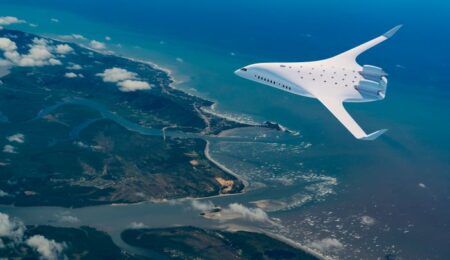Transporting the Vulcain 2.1 engine to DLR in Germany. Photo via ArianeGroup.
Engineers at the German Aerospace Center have carried out the first successful test of the Vulcain 2.1 engine on test stand P5 at the DLR site in Lampoldshausen.
The Vulcain 2.1, which has been developed by the ArianeGroup, is the most powerful rocket engine being developed in Europe. It will carry the latest European launcher, Ariane 6, into space in 2020. The engine has been designed to achieve greater efficiency at lower costs.
The development engines are being tested to show that they can cope with up to 130 tons of thrust, temperatures of around 3000 C in the combustion chamber and the high rotational speeds of the turbo pumps and the pressure in the propellant lines.
Stefan Schlechtriem, director of the The German Aerospace Center (Deutsches Zentrum für Luft- und Raumfahrt; DLR) Institute of Space Propulsion, said, “We can evaluate the functional capability of the engine for the main stage only by constantly carrying out tests, in which we gradually take steps towards its ultimate use in space,”
The test on the Vulcain 2.1 main stage engine lasted 11 minutes, roughly a third longer than the engine would need for it to carry the Ariane 6 launcher up into space, assisted by solid-propellant boosters.
A total of 12 firings over seven months are planned for the first test campaign at DLR.
Its predecessor, the Vulcain 2 main stage engine, is used on the Ariane 5 launcher and has completed 70 successful flights so far.
To create a more cost-effective and efficient generation of engines, the Vulcain 2.1 engine features a 3D-printed gas generator, a redesigned, simplified nozzle and a combustion chamber that can be ignited by the launcher’s ground support system.
Vulcain 2.1 will play a key role in carrying Ariane 6 up to an altitude of 150km within the first 10 minutes of flight.
Ariane 6, which has been in development since December 2014, is an enhancement to the existing Ariane 5 launchers and will be able to transport a payload of up to 11 tons into space, halving the cost of launches.
For the Vulcain 2.1’s second test run, the combustion chamber will be ignited from the test stand using propane gas. At the end of the test campaign, the engine will have to successfully complete a final rehearsal on the DLR test stand in its definitive flight configuration.
The results of the tests will be used by ArianeGroup engine developers to draw detailed conclusions about technical issues. The final design of the main stage engine requires a thorough understanding of the pressures and temperatures in the propellant lines, the rotational speeds of the turbo pumps, the pressures in the gas generator and combustion chamber, and the resulting vibrations to which the engine is subjected during a hot run.
Anja Frank, head of the department of test facilities at DLR Lampoldshausen, said, “Testing is not just about seeing how this technology fares under normal operating conditions. We want to look at how it copes with stresses that go beyond those normally experienced in flight – in other words, at higher temperatures, at high and low combustion chamber pressures and with different fuel mixture ratios. “We are using the development engine to assess the limits of the Vulcain 2.1.”
25 January 2018




